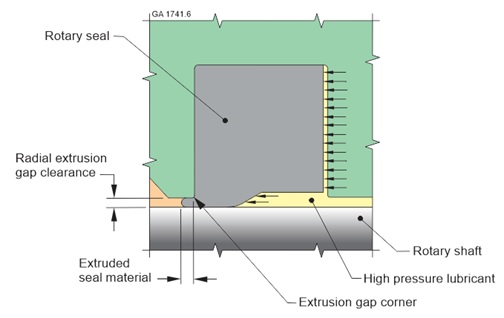Can rotary seals handle high pressure and high temperature?
Kalsi Seals are polymer based rotary seals that are used to seal the clearance between a shaft and a housing. The ability of a polymer to bridge high differential pressure decreases as the seal temperature increases, because the modulus of the polymer decreases. The compression set resistance of elastomer-type polymers also decreases with increasing temperature.
The running temperature of a polymeric rotary seal depends on several factors, including the environment temperature, the heat transfer response of the system, and the amount of heat generated by the seal. The amount of seal-generated heat depends on factors such as the width of the dynamic sealing interface, the rotary speed, the frictional characteristics of the polymer, and the degree of seal to shaft asperity contact within the interface. The interfacial lubrication provided by the hydrodynamic features of a Kalsi Seal minimizes asperity contact within the interface, lowering seal-generated heat. This allows the use of the relatively wide dynamic lip that is needed to resist differential pressure, giving Kalsi brand rotary seals a significant advantage over comparable non-hydrodynamic seals.

Although the temperature and resulting modulus of the seal material are key factors that govern the pressure capacity of a rotary seal, there are other critical factors. Three key hardware-related factors are the size of the clearance between the shaft and the housing, how much that size changes due to runout and deflection, and how frequently the size changes. The smaller the clearance, and the less it changes, the higher the pressure capability of the sealing assembly.
Because of the importance of hardware design, Kalsi Engineering publishes a rotary seal handbook that provides comprehensive coverage of hardware design practices, including detailed information on ways to minimize the clearance and movement between the shaft and the housing. We also offer a training course on hardware design, and have experienced staff members who can provide design guidance and feedback.

Although there are exceptions, Kalsi brand rotary seals that are intended for pressure retention service are typically made at least in part from HNBR for seal temperatures up to 300°F, and are typically made at least in part from FKM for seal temperatures up to 400°F. The actual differential pressure that a high pressure seal design can withstand is largely dependent on the combination of factors described above. When used with favorably sized clearance between the shaft and the housing, HNBR based seals can bridge relatively high differential pressure at 300°F, and FKM can still bridge moderate differential pressure at 400°F. Among our plastic linings, the -35 material retains modulus better at elevated temperature, compared to the -32 material. Contact our staff for more information.